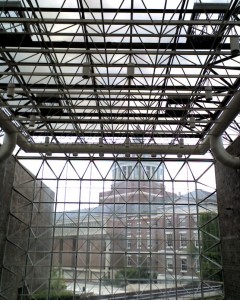University of Rochester
Sustainability @ the
University of Rochester
Wilson Commons Now Features LEDs
Earlier this year, lights above Wilson Common’s atrium were replaced by the latest in lighting technology. Light-emitting diodes, or LEDs, are known for their high light output for minimal energy input. Forty atrium lights were replaced with LEDs meaning an avoided cost of over $600,000 dollars over 20 years.
In the University’s ongoing pursuit to be a sustainable institution, energy saving retrofit projects are considered whenever feasible. As with most energy saving projects, the impetus for this project was not only to reap environmental benefits, but also to lower cost of operations. The original 500 watt quartz bulbs only had a lifespan of 2000 hours, and required replacement twice a year costing around $2,500 each time. Despite these disadvantages, it was difficult to find an alternate bulb, as they gave off sufficient light for the atrium that most bulbs could not. Eventually a substitute LED was found that can give an equal, if not more, amount of light, only require 132 watts of power, and have a lifespan of 115,000 hours (26 years). According to SmartWatt Energy, this significant reduction in energy is equivalent to planting 52 acres of trees, removing 33 cars from the road per year, saving 21,358 gallons of gas a year, and preventing 352,415 pounds of CO2 from entering the atmosphere every year. To maximize usage efficiency of the new lighting, a new control system was installed which uses an astronomic time clock and is scheduled according to building occupancy.
To defray initial costs, Rochester Gas and Electric provides financial incentives to corporations and universities who undergo projects to reduce their energy use. In this case, RG&E shared costs by covering 50% of the initial investment. Due to this help and the elimination of the financial burden of the quartz lights, the payback period for the project is 27.4 months, or a little more than two years.
This is not the first time LEDs have been installed on campus to great effect. In April 2002, LEDs were installed in 102 fixtures in Gleason Hall Room 318/418. As of publication, these lights have still not burned out. The University has reaped an avoided cost of over $30,000 dollars from this investment.
Besides Wilson Commons and Gleason Hall, LEDs have made their way into other campus operations. Around 25 of University Security Services’ Blue Light Emergency Phones have LEDs installed. As this program requires lights to be on 24/7, use of LEDs is a significant reduction in energy and maintenance costs. The new cafeteria at the Strong Memorial Hospital, Café 601, also has LEDs installed.
For more information about this project, please contact Eris Oleksyn, Maintenance Supervisor of River Campus Facilities and University Properties.
By Alanna Scheinerman, Class of 2013

